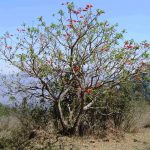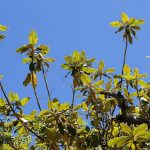TREE LIFE
MAY 1988
HARARE CALENDAR
Saturday 7th May : Botanic Garden Walk. Meet in the Car Park at 10.45 for 11.00 a.m. for another fascinating walk and talk in this jewel of Africa garden which we are so privileged to have in Harare. NB We have changed to Saturday mornings with the onset of winter and short evenings.
Sunday 15th May : Our monthly outing is to the Chinhoyi area and more precisely to Muni Farm hosted by Maude and Fred Wolhuter and Richard Schley who now owns the farm. The venue is actually beyond Chinhoyi off the Mhangura road which brings us close to Ditchwe and the Dolomite soils, springs and aquifers and this all makes for enticing botanical possibilities! An Express Motorways coach has been arranged and this will depart from Monomatapa Car Park (behind Livingstone House) at 8.15a.m. A security guard will be engaged to look after vehicles. Book with Joy Killion on 308398. Fare $18.
Saturday 21st to Wednesday 25th May : This is the supplementary outing on our calendar to the Mashonaland Hunters Association Camp near Chirundu. See last Tree Life for details or phone Meg Coates Palgrave on 84419.
Saturday 28th May : Mukuvisi Woodlands Meeting. Meet at 3.00at Paget Road/Inyanga Crescent gate.
28th/29th May : Outing to Masvingo. On the week end 28th-29th May we have been asked to run an outing for the Masvingo Branch of the Wildlife Society with the aim of introducing them to the identification and recognition of trees in that area. Any member who would like to join this outing and participate in the walkabout – i.e. guide a small party, should please contact Meg (84419 Harare) before 22nd May. (Dick will be on leave until 21st May). Please arrange your own accommodation.
Sunday 19th June : AGM : The 38th Annual General meting of the Tree Society of Zimbabwe will take place at the Harare Sports yacht club at Lake Macilwaine on Sunday 19th June at 10.00 hours.
AGM Agenda
- Notice convening the meeting
- Minutes of the last AGM (will be forwarded with June Tree Life)
- Matters arising
- Chairman’s Report
- Treasurer’s Report
- Election of Officers
- Any other Business
Any proposals/resolutions and nominations for office bearers (three Committee members wish to stand down this year) should be forwarded to P.O. Box 2128, Harare by 1st June 1988.
Details of the proposed programme after the meeting will be given in the June Tree Life.
Bus Outings : Transport services are becoming increasingly restricted for reasons that we all know. Be that as it may, we must do our best to help our transport organisers and all members are requested to :
- book early, certainly not later than the Thursday before the day of the outing. Positive bookings are essential – we can no longer assume that a member will use the bus unless he or she informs to the contrary
- cancel on time, certainly not later than the Thursday prior to the outing.
MATABELELAND CALENDAR
On Sunday May 1st we will go to Pasi Pasi area to study Acacia species; then on to the Simpson’s Ranch – Woodcroft Ranch. Meet at Falls Road Motors at 0830 hours. This is a morning trip only.
On Sunday, June 12th we will go, together with the Aloe and Cactus Society to Falcon College, Esigodini, to their Quiet Waters area and to do some tree naming. A good lunch, at $3.50 will be available, unless it is preferred to bring one’s own. We will hope to see some of our Shangani and Gweru friends too. Meet at the Hotel Rio at 0830 hours. Cars may be left there.
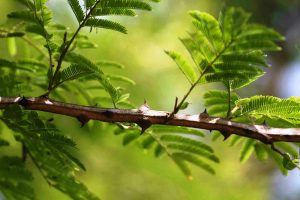
Acacia ataxacantha. Photo: Bart Wursten. Source: Flora of Zimbabwe
On Easter Sunday, April 3rd, we went to Hillside Dams where we had an interesting morning, with a good turn out. The Upper Dam is full and the Lower has some water in it. Just opposite our cars, parked below the Aloe Garden, was a splendid Pterolobium stellatum in full flower. We also saw the handsome, contrasting scarlet pods later. This would seem to be a good garden subject, prickles and all. Not far beyond, we could compare Acacia ataxacantha, with its flat leaves, smaller leaflets, of lighter green, thorns scattered singly along. This, of course, the Flame Thorn, has white spike flowers and red pods, turning brown, none however visible on this day.
Later, below the dam wall, we saw the great, thick, knobbed stem of an exceedingly ancient Pterolobium. There were many very fine Acacia galpinii and we wondered about their age which must be considerable, a lot of Acacia nilotica, the scented-pod Acacia, Acokanthera rotundata, Albizia amara, some big Azanza garckeana, well glanded below, but no Dombeya to contrast, a very large leafed Brachylaena rotundata, Bridelia mollis, Canthium lactescens, Carissa edulis, rather flattened and open, Celtis africana, well represented much preferring the better rainfall areas (the Hillside Dam area of course, is a micro-climate of its own), Clerodendrum glabrum, widespread, as was their smell, Commiphora mollis varying a bit, Croton gratissimus, badly eaten by something, some very large Dichrostachys cinerea, Dovyalis caffra with long straight thorns, 500mm or more, some very small Euclea divinorum and Euclea natalensis, Ficus ingens, Ficus thonningii, Grewia flavescens, Maytenus undata, its white powdery bloom contrasting with Brachylaena’s white loose skin, Pappea capensis, Pouzolzia mixta (we regret the loss of the descriptive hypoleuca) Rhus tenuinervis, Schrebera alata, some with very thick rough leaves, Vangueria infausta, fruiting well already, and some thick leaved Ziziphus mucronata.
-C. Sykes
20TH MARCH 1988 ; OUTING TO IJAPO FARM,CHEGUTU
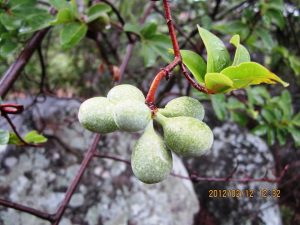
Artabotrys brachypetalus. Photo: Bart Wursten. Source: Flora of Zimbabwe
Ijapo,at the end of the Black Adder road, was the venue for March, and after a quick ‘cuppa’ our chairman chivvied us off to the banks of the Mupfuri (old name Umfuli) river, where happy surprises awaited. Overlooking the Black Adder rapids was a large Artabotrys brachypetalus in full fruit, many turning purple, the peduncles curling and then abruptly bending at a right angle so that the common name, Purple Hookberry was self explanatory. Some tasted the fruit and found them quite pleasant. The Artabotrys was large, almost smothering an Afzelia quanzensis. This was recognized by its compound leaves, the rims and main veins of the leaflets drawn in creamy-yellow, the top surface darker green than the underside. The tips were notched and quite unmistakable for this tree is the fact that the petiolules have ‘half a turn twisted’. Nearby was an Antidesma venosum also profusely in fruit, overhanging rocks and pools. The fruit in long tassels here were beginning to change colour. Elsewhere we found ripe seeds for the bird lover to try growing in her garden. Another potential garden subject, Erythroxylum emarginatum competed with Dalbergia melanoxylon, Tarenna neurophylla and Securinega virosa for our attention. Erythroxylum has attractive white flowers, red fruit and shiny leaves, whose waxy surface crackles audibly when folded over.
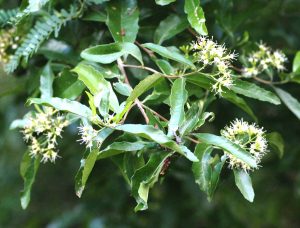
Nuxia oppositifolia. Photo: Bart Wursten. Source: Flora of Zimbabwe
Nearer the main river, Mimusops zeyheri, Nuxia oppositifolia, the River rhus, Rhus quartiniana – its soft leaves still a fresh light green. Mundulea sericea – with a few pinky-purple flowers still to be seen, and dried seed pods for the keen gardeners to try – all crowded over Maytenus undata. We do not see this very often and without Cheryl to remind us, forgot to look for the waxy powdery bloom on the leaves, which here were silvery-green. Ficus abutilifolia, with fleshy light green leaves and the main veins and petioles pink-tinted, its trunk pale yellow-grey, stunted and contorted, struggled its way over boulders. Had Tolkien see this tree, it surely must have had a place in the Lord of the Rings. In the distance, Ficus sur held its own in a deep sand bank. The rosette-leaved terminalia, Terminalia stenostachya, growing amongst the rocks, was accessible for us to see its large dark leaves earning its name. Enough leaves also grew along the young branches to show the origin of the marked leaf scars which are a helpful guide also for this tree.
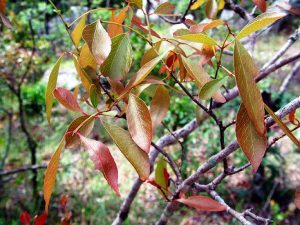
Pleurostylia africana. Photo: Bart Wursten. Source: Flora of Zimbabwe
From that point, the brave prepared to follow our chairman along and down the cliffs edging the river, whilst others kindly kept me (frankly agrophobic) company over the hill. Rhoicissus revoilii and Margaritaria discoidea hunched over different bounders. Pleurostylia africana stretched up from the base of others, its newly emerging leaves at the tips of the branches a delicate coppery-red. Ficus ingens, footing another rock, overshadowed Strychnos potatorum, whose leaves paired in typical Y fashion, were beginning to show the brown blotches that make this tree unmistakable in winter. Pterocarpus angolensis lifted lime-green prickle-centred fruit to the sky and an unusually tall Steganotaenia araliacea wriggled through more Terminalia and Lannea discolor to reach the light. Kirkia acuminata delighted with lacy lightness of leaflets against the blue of the heavens, and my children’s natural jungle-gym tree, Bauhinia petersiana still held a few white petalled, maroon-pink stamened flowers against the beetles. Combretum apiculatum and Combretum mossambicense grew on this hillside, and Commiphora mossambicensis greeted us on the next ridge. Meg later demonstrated that its trifoliolate leaves, when crushed, give off a spicy smell, earning it the name of Pepper Commiphora. Near the crest we were able to compare Commiphora mollis with C. africana, both soft leaved, but C. africana is a somewhat rigidly drooping narrow tree, has serrated trifoliolate leaves, whereas C. mollis is a larger, more spreading tree in habit, with compound leaves, 2 – 6 paired leaflets, margins entire and the tip often sharply tapered.
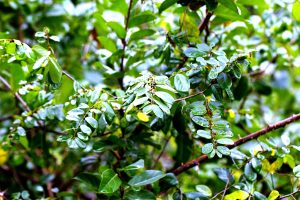
Bridelia cathartica. Photo: Bart Wursten. Source: Flora of Zimbabwe
We compared Bridelia cathartica having knobbly branches and the remains of the branchlets and sepals of the fallen fruit with B. mollis, the leaves very large, and wider towards the apex, soft and furry to the touch. The glory of those granite kopjies, their Brachystegia glaucescens to my mind more beautiful even that the Msasa is new leaf, overhung our walk, delicate yet majestic, and tantalising to those of us who wish we were artistic. To one side, Albizia tanganyicensis displayed a little of the paper-peeling bark which becomes so striking to the eye as winter advances, and young Albizia antunesiana, purple-leaved, still grew close to the ground.
Over the summit, on a ledge overlooking the river, a large Sterculia africana with dark pink bark, in full foliage, overshadowed Aloe excelsa, Erythrina abyssinica and (new to me) Carphalea pubescens, carrying the dried flowers that give it the common name – ‘cups and saucers’. On the edge of the rock face, we saw a Pteleopsis anisoptera, its grey green leaves with rolled under margins, sub opposite along the branchlets and rosette-like close at the ends. This shaded a fairy glen of mosses, ferns and dainty wild flowers, edged above by Pouzolzia mixta with leaves furry white on the under surface and Tetradenia riparia (from which my father used to tell us, the Zulu used to make a cough remedy and so he called it the Coughing Goat Bush, to my mind much more fun than the common name Ginger bush). Euphorbia matabelensis with branches growing in angular pattern, not yet in their winter maroon livery, and Euphorbia griseola, in miniature as we so often see it, both stood as inspiration for tales of fantasy or childhood dreams. I was an entrancing spot, so we rested a while to enjoy the sight and sound of the river rushing down the gore, and rejoiced to think of all the full weirs along its course.
On the walk back to the farm house were enough species to keep us busy for a day, Strychnos innocua, spineless, with almost velvety leaves and smooth powdery bark bore young fruit, but Strychnos spinosa, with shiny dark leaves and paired curved spines, did not seem to be in fruit. Nor was Crossopteryx febrifuga which is now well known to us in Chegutu so we did not stop to look for the crystals in its bark, and we walked past Parinari curatellifolia with scarcely a glance. It too, contains silica crystals in its bark, which blunt saw blades and tools, and so perhaps gives the tree some protection from man. Burkea africana, with russet velvet growing tips, Brachystegia boehmii, Ozoroa insignis had all been chopped out in the past and were slow in recovering, so many of these were not good specimens. But Acacia polyacantha and A. goetzei were gaining ground quickly in places. Protea angolensis with light blue-green leaves faintly red tinted in their youngness, contrasted with the neat, shiny leaves of Ochna schweinfurthiana, large enough for its finely tessellated bark to be distinguishable. Of special interest, Monotes glaber and M. engleri were seen growing almost arm in arm, and both in fruit. We looked to see the extra floral nectary at the base of the leaves, noting that M. glaber has shiny yellow-green leaves, while M. engleri has two tones leaves, dark blue green above, white and hairy underneath, and that the fruit of this tree seemed generally larger than those of M. glaber (have you noticed the refreshing rose water fragrance of the latter when in flower). Near the house was one of the largest Euclea divinorum that we have come across, a real tree rather than a shrub.
And so to our picnic lunch in the shade of a fine Ficus thonningii, with a view of a super Brachystegia boehmii shading the farmhouse and the company of friends. How rich we are. Yet there was more pleasure to come in the afternoon visit lower down the gorge by a less precipitous route! We went in search of Manilkara mochisia and found it. It was interesting to see it clinging on persistently to islands in the river bed, elsewhere in Chegutu we have seen it growing to a really good size on anthills. Hippocratea parvifolia puzzled us for a while, then Olax dissitiflora had us crushing leaves, hoping to detect the almond scent as the released chemicals, re-acting, produce cyanide – I shall keep trying it, Kim. Garcinia buchananii produced yellow sap when leaves were broken, and then just before we turned to return, another rare treat – Gardenia resiniflua. It was a small specimen, but with enough leaves for us to see how it differs from the Gardenias that we know better. It was almost velvety in appearance, especially underneath, with veins neatly defined in yellow.
Storm clouds closed in and sent us on our way home after a day to be encapsulated in memory. The trees. I remembered to mark off 104, how many did I miss. The river in glorious spate. Water-washed pebbles. The kopjies against a stormy sky. The fairy glen. And by no means least, the good companionship. If only those who look on us as a little nutty could experience the pleasure of these days together they would realise the worth of the society, and if one of our aims is to spread knowledge and interest in our trees and the bush, then perhaps we should promote our outings more vigorously?
-Ann Bianchi
The write up for the morning part of the outing on 17th April will appear in the next month newsletter. For the afternoon Janet gave us these notes :
After a leisurely lunch, tree spotting proceeded. The first exciting find of the afternoon was Xanthoxylum capense (Fagara capense before its name change). The tree was full of fruit – tiny little oranges. Their size belied their scent, an almost overpowering smell of citrus. Right next door we found Erythrococo trichogyne and a very fine large specimen of Olea europaea. On down toward the spillway past Celtis africana, Strychnos potatorum, Cassia singueana, Grewia flavescens, Dalbergia nitidula and Azanza garckeana. Down amongst the fig trees the debate started, Ficus natalensis, F. thonningii, ?F. ingens?? Opposing view from Meg and Kim and some confusion amongst the rest of us. Perhaps we need a fig day to get them all sorted out.
One of the final treasurers was the sight of the tiny flowering plant parasite Pilostyles in bloom on a Brachystegia spiciformis. It was the fourth parasite of the day and in common with the other parasites seen as it was on a leguminous host. It is most interesting that these parasites seem to favour legumes as hosts – possibly as a means of obtaining extra nitrogen.
After a short walk back to the car park past Croton gratissimus and a heavily fruiting Combretum zeyheri it was time to depart. Another very successful day amongst the trees over.
-Janet Touchy
BOTANIC GARDEN WALK, APRIL 1988 :
We continued with species from the Zambezi Valley for the benefit of the key and looked at the COMBRETACEAE. Together with the aid of the Kirk Society of the University I have put together the following rough key which I assure you was not an easy task. Please would members test the key either in the Botanic Gardens or any where else where these species occur.
DICK HICKS CHAIRMAN


